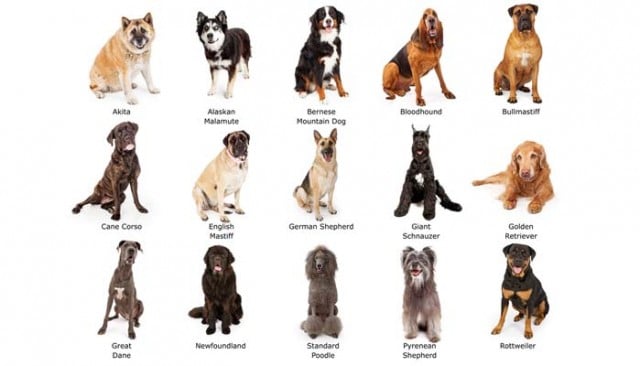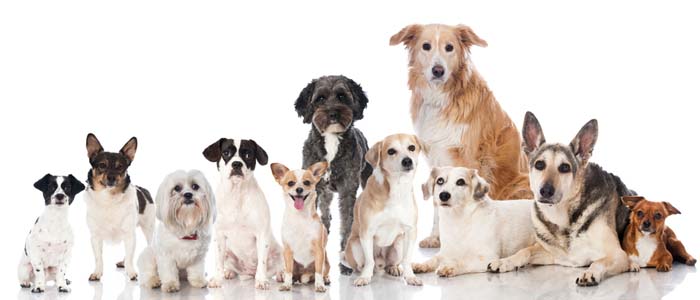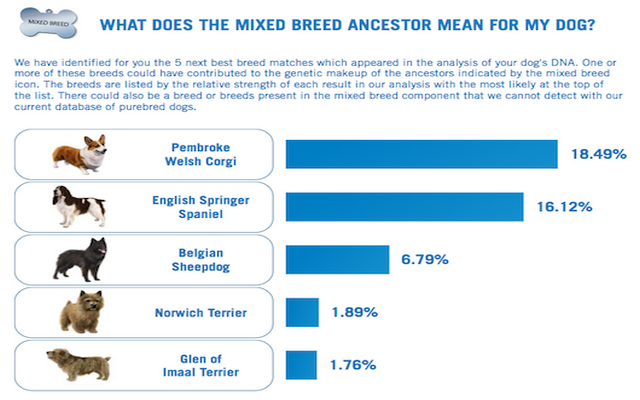
Table of Contents
A year ago, I got my mixed-breed dog Lily. She was only given by a family friend, who said she was a purebred Golden Retriever.
But as she got older, I noticed her appearance change. She's slightly smaller, and her coat didn't really grow into the length expected in a GR.
But she sheds. Like, a lot.
Since then, I've always wondered what her lineage is.
If you're like me, who has zero clue and asks the question, “What breed is my dog?” I did the research, so you don't have to.
In this article, we'll discuss the different ways to check what breed a dog is and why it's important for us pet parents to know this.
Spoiler alert: Our best choice is to get our dogs DNA tested!
But are DNA tests for dogs really effective?
Embark Founder and CEO Ryna Boyko said yes, they're effective and beneficial for both owners and dogs in the long run.
“Having a comprehensive dog genetic profile like we provide lets an owner know, first of all, what breeds are in their dog if they don't know, which gives ideas about personality and some disorders and all that, but also lets you know your dog uniquely, what kind of health concerns he might have, what's in the traits and other kinds of things about your individual dog,” Boyko said.
You can listen to our podcast, where my colleague Samantha and Embark's Ryan Boyko talked about how effective and beneficial DNA tests are for dogs.
We'll also discuss that here in a bit.
WATCH & READ MORE: Embark Dog DNA Test Kit Review & Testing the Kit
How to Tell What Breed Is My Dog?
1. Search through Dog Photos
Many websites offer help in determining the breed of your dog.
DogBreedInfo.com and PetFinder.com are two of the most popular sites for people who are trying to figure out which breed of dog they have.
You can also visit the American Kennel Club's website to compare the physical traits and characteristics of your dog and the breed you suspect him to be.
It may be a tedious and time-consuming way to guesstimate what breed you have, but comparing your dog to pictures of different breeds may be the simplest way to figure this out.
If you actually have a purebred dog, lucky you because this process might just work.
But if your dog is a mixed breed like mine, then it will be a lot harder and more tedious than you and I would like.
There are mixed breeds that are made up of 10 or more breeds. It can be nearly impossible to tell their breeds just by looking at photographs.
If your dog is fully grown, you could take measurements and observe some of its features, including coat color, fur thickness, temperament, and physical structure.
Doing research on these qualities will help you narrow down the search as well.
RELATED: Do Dog DNA Tests Work? How Accurate Are They?
2. Use Dog Breed Identifier Apps
It's tedious having to go through hundreds of dog photos to see which one would closely match your dog's appearance.
Technology to the rescue!
Many different apps are now available to download on your smartphones that claim to help you scan your dog's breed.
All you have to do is take your dog's picture, upload it on the app, wait for a few minutes while it scans, and voila.
Some apps even have extra features like a human-dog translator, where they can turn your “I love yous” into “Woofs!”
Well, who knows if they're accurate, but at least they're fun!
Here are the highest-rated apps that are available for both Apple and Android users:
Another option if you're not keen on downloading another app on your phone is by checking this website.
The Dog Key website will ask you a couple of questions about your dog's physical traits, like weight, ear shape, tail shape, and many more.
3. Get a Dog Professional’s Opinion
Talking with professionals who have lots of experience with many different types of purebreds and mixed breeds is an excellent way to find out which breed of dog you have.
Obviously, your veterinarian will be of big help, and this should be your first point of contact whenever you're puzzled about what breed your dog is.
Alternatively, you can also rely on the knowledge of professional dog groomers, dog walkers, breeders, and other pet care professionals.
Because these people deal with different dogs, different breeds, on a daily basis, they may be able to give you a more accurate assessment of what breed of dog you have, too.
RELATED: How to Choose a Dog Breed?
Another option is animal shelters.
These places also see a lot of different breeds on a regular basis, and it's their job to be able to make a call about what breed of dog they've just accepted into the shelter.
For a second opinion, try to get some information by talking to the employees of the local Humane Society, shelter, or rescue in your area.
Think outside the box when you're looking for advice on your dog's breed.
Anyone with a lot of canine experience may have some insight.
You could chat with employees and pet parents at your local dog park or talk with professionals at your local pet store as well.
A former associate editor at Top Dog Tips, Catherine, has written a column on how she didn't make a proper assessment of the adopted dog's breed and thus has given her sister a wolf-dog hybrid unintentionally.
Read her awesome Wolf-dog Hybrid column here.
4. Try a Dog Genetic or DNA testing kit
If you are really concerned about finding out exactly what breed or breeds your dog is made up of, you can purchase a dog DNA test.
The tests start around $60-$70 and go up from there.
The biggest factor in price is how big the database of dog breeds the company/manufacturer has.
For example, the more dog DNA samples the company has in its database to test against, the more expensive the test will be, but it will also be more accurate.
Therefore, if you have a mixed breed, it would be more beneficial to go with a company that has a larger database so you can receive as much information on your dog as possible.
RELATED: Canine Genetics – How to Make a Dog
All the dog DNA kits are relatively the same. They will include a cheek swab and a sealed sample packet.
All you have to do is swab your dog’s cheek, place the swab in the packet, seal it, and mail it back to the address provided.
The most expensive DNA tests for dogs require a blood sample, and you can only get these at a certain veterinarian’s office.
In my colleague Samantha's interview with Embark CEO Ryan Boyko, he advised pet parents to have the test done the earlier, the better.
“The earlier you can test, the more time you have to potentially change the course of the dog's life through changing their lifestyle or their diet or other things, and the more time you have to accrue that benefit,” Boyko said.
A good rule of thumb to remember about canine DNA testing is that the more breeds the dog is made up of, the less accurate the test will be.
If your dog is only made up of one or two breeds, you can be sure the results are very accurate, but if your dog is a true mutt that is made up of many breeds, the test may not be able to identify them all accurately.
Why Should You Know Your Dog's Breed
Knowing your dog's breed can be beneficial in many ways for both you and your canine companion.
According to Genetic research, the type of breed does indeed explain many aspects of a dog's unique personality.
Breed designations can be used to predict your dog’s upcoming behavior issues and educate you on some of the common health issues that he could face in the future.
Dogs come in all shapes and sizes, and it can be very hard to distinguish between them if you don’t have much experience with a large assortment of breeds.
Many canine breeds are predisposed to common health conditions.
Some are more prone to developing cancer or heart conditions, while other breeds are more likely to have issues with arthritis or hip dysplasia.
Certain breeds have more energy than others, and some are very prone to anxiety issues.
RELATED: Should You Breed Your Dog?
While it's not vital, it's definitely advisable to find out what breed your dog is.
Knowing exactly the breed or breeds of your pet can help you identify some potential health problems before they become a major issue and take preventative measures.
You can also accommodate your dog's requirements for exercise and diet better, too.
For example, if you know your canine's breed is more prone to dog arthritis, you can talk with your vet about joint supplements for dogs to help prolong their joint health well in advance, and you can be on the lookout for early warning signs and respond accordingly.
FAQs about knowing What Breed a Dog is
Can you tell a dog's breed from DNA?
Yes, you can tell a dog's breed from DNA testing.
DNA testing can provide valuable information about a dog's ancestry and breed composition.
Typically involving a simple cheek swab or blood sample, the test will analyze the dog's DNA and compare it to a database of known breeds to determine the dog's breed composition.
While DNA testing can provide useful information about a dog's breed, it's important to note that it may not be 100% accurate, especially for mixed-breed dogs with complex genetic backgrounds.
Additionally, DNA testing cannot predict a dog's behavior or health conditions, so it's important to evaluate a dog based on their individual personality and health history.
How do I know if my dog is purebred?
There are several ways to determine if your dog is purebred:
1. Pedigree papers: If you obtained your dog from a breeder, they should have provided you with pedigree papers that document your dog's ancestry. These papers will show the dog's lineage and can confirm their purebred status.
2. Breed standards: Each breed has specific physical and behavioral characteristics that define the breed standard. You can research the breed standard for your dog's breed and compare it to your dog's appearance and behavior to determine if they match.
3. DNA testing: DNA testing can also be used to determine if your dog is purebred. DNA testing can analyze your dog's genetic makeup and compare it to a database of known breeds to determine their breed composition.
It's important to note that even if your dog is not purebred, they can still be a wonderful companion and member of your family.
What is dog wolfiness?
Dog wolfiness refers to the degree to which a domestic dog exhibits physical or behavioral traits that are similar to those of wolves.
Some dog breeds, such as the Siberian Husky and Alaskan Malamute, have been bred to retain some wolf-like traits, such as a thick coat and a strong prey drive.
Wolfiness can also refer to a dog's genetic makeup, as some dogs may have a higher percentage of wolf DNA than others. However, it's important to note that even dogs with wolf DNA are still domesticated animals and are not the same as wild wolves.
You can also identify your dog's wolfiness through DNA tests.
What Breed is My Dog: Before You Go…
Asking the question, “What breed is my dog?” and actually trying to find ways to answer this question is not vanity.
It's not only about knowing that we have the most exquisite breed or mix of breeds, but it's also about learning how we can take care of them better.
You can get a rough idea from easier techniques like identification charts, scrolling through photos, or downloading apps on your phone.
But if you want a more accurate result, doing a DNA test is the best way to go.
Regardless of whether your woofer is purebred or a mix, DNA kits may quickly and inexpensively analyze his genetic makeup and reveal what breed he is.
Are you interested in trying the methods that we've discussed above? Share with us your experience in the comments section.
While I'm ordering a DNA kit on Amazon to try on my dog, you can go ahead and check out related and recommended articles that I've linked below!
Related Articles:
- How to Accurately Use Dog DNA Tests
- 25 Best Mixed Breed Dogs to Adopt
- Mixed or Purebred: Which Is Best?
- New Breed Finder Tool Released By Vetstreet.com
Disclosure: We may earn affiliate commissions at no cost to you from the links on this page. This did not affect our assessment of products. Read more here and find full disclosure here.

















